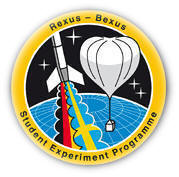|
The peculiarity of an Inertial Navigation System (INS) is that does not
require any external reference in order to determine position,
orientation, or velocity. INS is the only self-contained navigation
system, therefore it is specially suitable for applications on rockets
or balloons.
Low.Co.I.N.S is a low cost inertial navigation system intended to be
flown onboard BEXUS
stratospheric balloon.
Our experiment is based on a strapdown design that foresees the use of
accelerometers and gyros rigidly connected to the vehicle. Inertial
measurements are gained by MEMS-based motion sensing devices and a
microchip PIC microprocessor will collect those data, downlink to
ground and store them into a flash memory.
Inertial
navigation techniques recently faced important developments with the
introduction of very low cost sensors, collectively labelled as Micro
Electro Mechanical Systems.
Our
experiment is a test of our capability in the determination of the
cinematic state of the Bexus payload gondola through the design and
validation of an inertial navigation system built with low cost
commercial off-the-shelf components.
The sensors
involved in the experiment have to provide measurements of
accelerations, angular rates, magnetic field strength and direction, as
well as atmospheric pressure and internal experiment temperature. The
accuracy of these data makes possible the determination of the position
and the attitude of the Bexus payload gondola with a precision that we
want to evaluate and increase as much as possible.
MEMS sensors
may not be able to provide inertial measurements with a sufficient level
of accuracy needed in cutting-edge inertial navigators, however they
might be accurate enough to allow for navigation where pinpoint accuracy
is not required or where periodic re-alignment is made available through
other measurements (eg. GPS and/or magnetometers).

Our experiment consists mainly in the determination of the position and
attitude of the payload gondola during the entire flight time.
Accelerometers and gyros will sense acceleration and angular rates along
three orthogonal axis, thus integrating those measurements in an
opportune reference frame, the position and attitude of Bexus can be known once initial conditions have
been specified.
Being a dead-reckoning process, where either attitude or position is
evaluated using the state at the preceding time and adding the rate of
change times the time interval, the calculated solution will sooner or
later diverge from the true solution due to the accumulation of errors.
Therefore it is necessary to periodically re-align the navigation
platform using other references. These can be the Earth magnetic field
vector that can provide the direction of the magnetic north as well as a
reference around which is possible to determine the attitude. Barometric
altimeter may be an effective reference and can be used to compare the
calculated position along the vertical axis. Finally, during the post
processing, also GPS data can be used for platform re-alignment as well
as a benchmark.
Dead-reckoning also means that it is required to have an uninterrupted
data flow from sensors, as if some measurements are lost, even for a
small time interval, there is no more way to estimate correctly the
cinematic state and the flight trajectory after the loss of data will be
unrecoverable. That is why, even if we continuously downlink data to
ground, we decided also to store all data gathered in a flash memory
onboard. So, even a temporary loss of telemetry data stream will not
affect the results of the experiment.
The
reconstruction of the flight trajectory will be attended on the ground. Once the experiment has been
recovered, the memory will be dumped and an exhaustive post-processing
will occur with all the data gathered by the unit. During the
post-processing the flight trajectory will be reconstructed in several
methods and compared with GPS data, then exhaustive data analysis and
comparison will be attended in order to find out the best solution.
|



